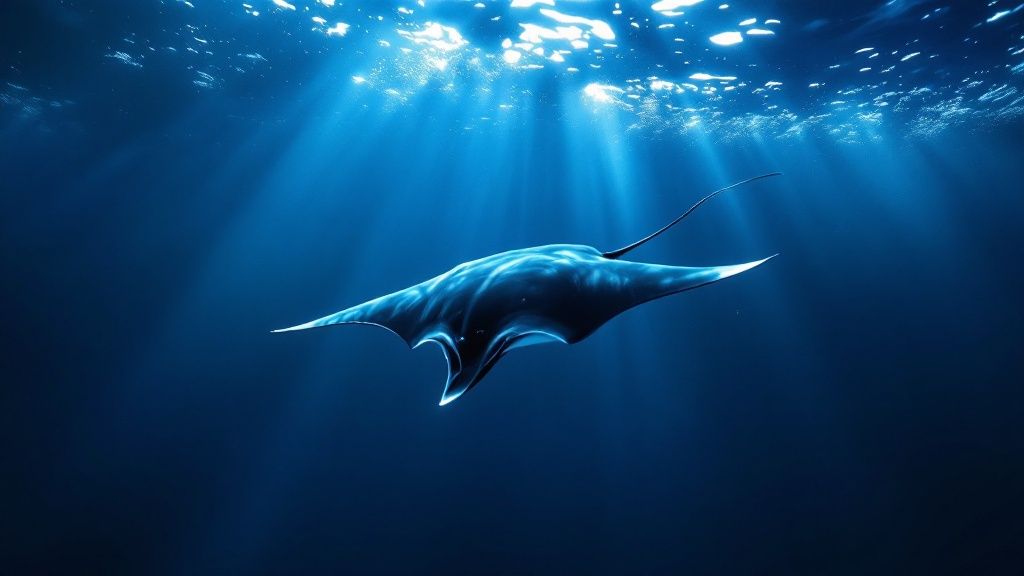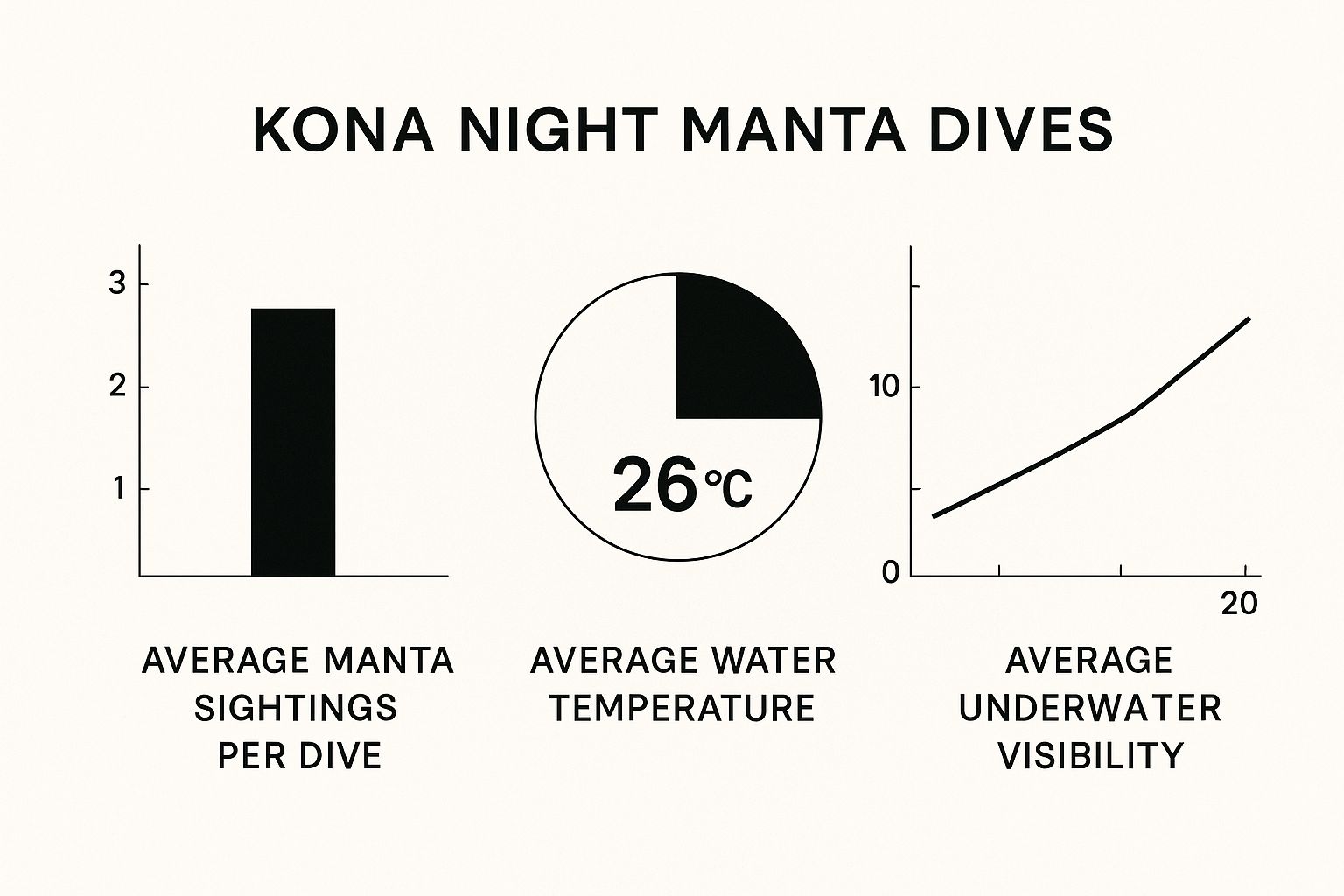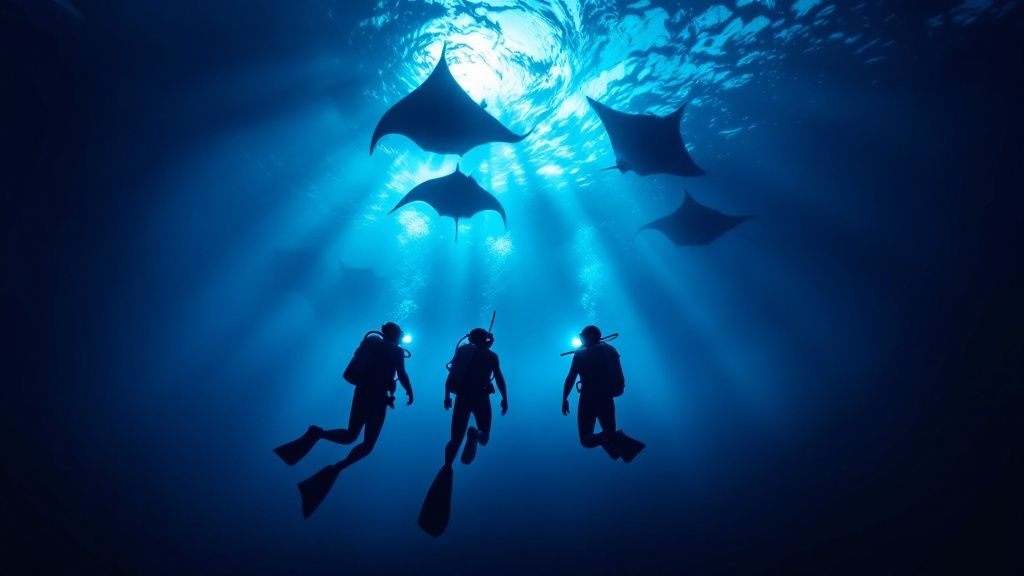Why Kona's Manta Dives Captivate the World
Kona, Hawaii, is more than just a beautiful island destination; it's a world-renowned hotspot for manta ray encounters. This unique ecosystem draws divers and snorkelers globally, setting the standard for manta ray experiences. What makes Kona so special? It's a combination of volcanic topography, nutrient-rich waters, and dedicated conservation efforts.
Kona's volcanic origins have created a dramatic underwater landscape, filled with protected coves and nutrient-rich upwellings. These upwellings are a feast for plankton, the manta ray's main food source. These natural gathering spots become a stage for mesmerizing underwater ballets, as mantas gracefully glide through the water, filtering plankton with their cephalic fins. This reliable food source makes manta ray sightings in Kona remarkably consistent. Interested in learning more? Learn more about manta ray dives in Kona.
The Science of Manta Aggregation
The predictability of these gentle giants isn't by chance; it's rooted in the science of Kona’s ecosystem. The unique underwater topography, coupled with consistent currents and ideal light conditions, creates an optimal environment for these creatures. The area also boasts a thriving plankton population, ensuring a constant food supply that draws mantas in.
This reliability has transformed occasional manta sightings into one of the most dependable wildlife encounters globally. Manta dives in Kona are known for their high success rates, with local operators like Jack’s Diving Locker reporting manta ray sightings in approximately 85-90% of dives. This high frequency is due to the predictable presence of mantas, making Kona a perfect location for both tourists and researchers. The local manta population is estimated at over 450 individuals, further increasing the likelihood of encounters. Find more detailed statistics here.
Conservation and Research: A Symbiotic Relationship
The consistent presence of mantas provides invaluable research and conservation opportunities. Scientists can study manta behavior, social structures, and reproductive patterns in their natural habitat. The thriving manta dive industry plays a vital role in funding these research efforts.
This creates a beneficial relationship between tourism and conservation, ensuring the long-term protection of these magnificent creatures and their habitat. This careful balance allows Kona to preserve this extraordinary marine phenomenon while supporting scientific research that deepens our understanding of these gentle giants.

Kona's Premier Manta Dive Sites Uncovered
Kona, Hawaii, is renowned for its incredible manta ray diving experiences. The island's volcanic formations create a unique underwater world, rich with nutrients and sculpted by ancient lava flows. These special conditions provide a perfect habitat for manta rays, offering divers an unforgettable opportunity to witness these gentle giants up close.
Manta Village and Manta Heaven: Iconic Dive Experiences
Two of Kona's most iconic manta ray dive sites are Manta Village and Manta Heaven. Manta Village, located off the coast of Keauhou, is known for its incredibly high manta ray sighting rates. Dive operators often report seeing mantas on nearly every dive at this location. Manta Heaven, situated near the Kona International Airport, offers the chance to see larger groups of mantas congregating together. Both sites offer unique underwater landscapes and lighting conditions, creating distinct diving experiences to suit various preferences.
Beyond the Famous: Hidden Gems for Seasoned Divers
While Manta Village and Manta Heaven are popular choices, Kona also offers some hidden gems for more experienced divers. These lesser-known sites provide a more intimate encounter with the manta rays, away from the larger crowds. The Kohala Coast dive sites, located further north, offer a quieter, more personal experience with fewer divers. These locations often reveal unique manta ray behaviors rarely seen in more popular areas, making them perfect for seasoned divers looking for a fresh perspective.
To help you choose the perfect dive site for your experience level, we've compiled a table comparing some of Kona's top manta ray diving locations:
To help you choose the perfect spot for your next dive, we've compiled this handy comparison:
Top Manta Ray Dive Sites in Kona: Comparison of the main manta ray dive locations in Kona, including key features and best times to visit
| Dive Site | Location | Best Time | Average Depth | Experience Level | Special Features |
|---|---|---|---|---|---|
| Manta Village | Keauhou | Sunset-Night | 10-15m (33-50ft) | Beginner – Advanced | High sighting rates, easy access |
| Manta Heaven | Kona Airport | Sunset-Night | 12-18m (40-60ft) | Beginner – Advanced | Potential for large groups of mantas |
| Garden Eel Cove (Kohala Coast) | North Kohala | Daytime | 5-12m (15-40ft) | Intermediate – Advanced | Quieter, more intimate experience |
| Mahukona (Kohala Coast) | North Kohala | Daytime | 10-20m (33-66ft) | Advanced | Unique manta behaviors, strong currents possible |
This table highlights the diverse options available to manta ray divers in Kona, from easy access sites perfect for beginners to more challenging locations suited for experienced divers. Remember to always consult with local dive operators like Kona Honu Divers for the most up-to-date information on conditions and site suitability.
Understanding Kona's Manta Dive Conditions
The following infographic visualizes key data for Kona night manta dives, illustrating average manta sightings, water temperature, and underwater visibility.

This data showcases the favorable conditions for manta diving in Kona. With an average of three manta sightings per dive, comfortable water temperatures of 26°C (79°F), and excellent visibility averaging 20 meters (66 feet), divers can expect clear and engaging interactions with these magnificent creatures. These ideal conditions contribute to Kona’s reputation as a world-class manta dive destination. Keep in mind that these are averages, and actual conditions can change depending on the season and weather.
Choosing the Right Site for Your Dive
Selecting the ideal manta dive site depends on several factors, including your experience level and your diving goals. Each site has unique characteristics in terms of visibility, currents, and underwater topography. Researching these aspects beforehand will help ensure a more satisfying and safe dive. Consulting with local dive operators can provide invaluable insights into current conditions and help match your experience level with the perfect manta ray encounter.
Preparing For Your Manta Encounter
Preparing for your manta ray dive in Kona is key to maximizing your enjoyment and ensuring a respectful interaction with these gentle giants. Choosing the right operator is the first step. Look for operators committed to sustainable practices and marine conservation, prioritizing the well-being of the mantas and their environment. You might be interested in: Why should you go on a manta ray dive in Kona?
Gearing Up For The Experience
Veteran divers recommend specific equipment considerations for manta encounters. While most operators provide basic gear, having your own well-maintained equipment can enhance your comfort and experience. When planning your manta dive, ensure your equipment is well-maintained; you might find deals or specific equipment via sites that sell quality diving gear. A properly fitted wetsuit is essential for warmth, especially during night dives, as water temperatures can drop. A high-quality dive mask and snorkel are crucial for clear visibility.
Additionally, if you plan to capture the magic of your encounter, consider investing in underwater photography equipment suitable for low-light conditions. Understanding how to use your camera effectively in these conditions will allow you to capture stunning images without disturbing the mantas' natural behavior.
Accessibility For All
One of the most remarkable aspects of manta ray encounters in Kona is their accessibility. Even non-certified swimmers can participate through specially designed snorkel experiences. These tours provide flotation devices and expert guidance, allowing virtually everyone to witness this natural wonder. This inclusivity opens up the underwater world of manta rays to a broader audience.
The annual number of people participating in manta ray snorkeling and diving tours in Hawaiian waters is substantial, with approximately 80,000 individuals taking part each year. This underscores the popularity of Kona as a manta ray destination and the importance of sustainable tourism. Learn more about manta ray tourism in Hawaii.

Timing Your Dive For Optimal Conditions
Seasonal variations subtly influence water clarity and manta ray feeding patterns. While mantas are present year-round, some seasons offer better visibility and more active feeding. Consulting with local operators like Kona Honu Divers can help you determine the best time to visit for optimal conditions.
Preparing Mind And Body
Beyond equipment and logistics, preparing your mind and body can significantly enhance your underwater presence. Managing expectations is essential. While manta ray sightings are common in Kona, they are wild animals, and their behavior is unpredictable. Physical preparation, such as regular swimming or snorkeling before your dive, can improve your comfort and stamina in the water. Mental techniques, like deep breathing exercises, can help you relax and fully immerse yourself in the experience. By embracing these preparation strategies, you can transform your Kona manta ray dive into a truly memorable experience.
The Fascinating Science Behind Kona's Manta Magic
The magic of Kona's manta ray night dives isn't just a spectacle; it's grounded in fascinating biology and ecology. These gentle giants have evolved unique feeding strategies perfectly adapted to Kona's nutrient-rich waters. Let's explore the science that makes these encounters so captivating.
The Plankton-Light-Manta Connection
Manta rays are filter feeders, consuming vast amounts of microscopic plankton. Kona's volcanic slopes create upwellings, bringing nutrient-rich water to the surface. This fuels plankton blooms. At night, dive lights act like the moon's reflection, attracting plankton and creating a feeding frenzy. This draws in the mantas, resulting in an incredible display.
The intricate relationship between plankton, light, and manta ray behavior is what makes night dives so spectacular. Imagine witnessing these graceful creatures gliding through the illuminated water, feeding on the abundant plankton. It's truly a mesmerizing experience.
Manta Intelligence and Social Structures
While often seen as solitary, mantas possess surprisingly complex social structures. They communicate through subtle movements, and possibly even vocalizations, which are still being researched. Each manta also has unique belly patterns, like natural fingerprints.
Researchers use these patterns to identify individuals and track their movements. This has provided insights into their social interactions, migration patterns, and even individual personalities. It's remarkable to think that each manta ray has its own distinct identity.
Manta ray sightings on the Kona Coast have been meticulously documented, providing valuable data on their behavior and population dynamics. Manta Ray Advocates Hawaii has compiled statistics on sightings, starting in 2009. These records help researchers understand patterns in manta ray appearances and interactions. This data is crucial for effective conservation efforts. The ongoing research in Kona makes it a significant site for global manta ray study.
Acoustic Research and Navigation
Innovative acoustic studies are revealing more about manta communication and navigation. Researchers believe mantas may use sound to locate prey, interact, and navigate Kona's underwater terrain. Their precision is remarkable.
These studies are constantly expanding our understanding of manta ray sensory abilities and social behaviors. The more we learn, the more we appreciate the complexity of these amazing animals.
Citizen Science: Divers Contributing to Research
The manta dive community in Kona plays a vital role in ongoing research. Interested in experiencing a manta ray dive? Citizen scientist divers contribute valuable data through photographic identification and behavioral observations, assisting marine biologists.
This collaboration between scientists and divers is essential for expanding our understanding of these ancient creatures. It also strengthens vital conservation efforts, ensuring the long-term health and protection of Kona's manta ray population.
Day vs. Night: Two Distinct Manta Dive Experiences

Manta ray dives in Kona, Hawaii offer two incredible experiences: day and night. Each provides a unique perspective on these gentle giants, appealing to different interests and preferences. The transition from day to night transforms the experience from simple observation to a mesmerizing spectacle.
Daytime Encounters: Graceful Gliders in the Blue
During the day, manta rays appear as graceful figures gliding through the sunlit ocean. Divers and snorkelers can observe their natural behaviors. These include foraging for plankton and visiting cleaning stations, where smaller fish remove parasites. Day dives provide panoramic visibility, allowing you to appreciate the manta's size and effortless movement against the vibrant reef.
This makes daytime dives ideal for those who enjoy a wider view of the underwater world. You'll see the mantas interacting with their environment, a truly captivating sight.
Nighttime Encounters: A Ballet of Light and Shadows
As darkness falls, the manta ray dive transforms into something magical. The perspective shifts from the wide-angle view of the day to a closer, more intimate encounter. Dive lights attract plankton, creating a feeding frenzy that draws the mantas near.
They perform mesmerizing underwater ballets, swirling and looping just inches from the divers. This focused interaction offers a completely different sensory experience. The darkness amplifies the impact of the dive lights, highlighting the manta's intricate movements and unique belly patterns. For a deeper look into this unique experience, check out our guide on what a manta ray night dive is like.
Specialized Techniques for Night Dives
Kona's dive pioneers have developed special techniques to enhance nighttime manta ray interactions while minimizing environmental impact. Divers typically kneel or sit on the ocean floor in a semi-circle, shining their dive lights upwards.
This creates a feeding zone for the mantas, allowing for close observation without disturbing them. Proper lighting techniques and positioning are crucial for respecting these creatures and ensuring a sustainable interaction.
Choosing Your Ideal Manta Dive
The following table summarizes the key differences between day and night manta ray dives in Kona. It's designed to help you decide which experience best suits your preferences and diving goals.
Day vs. Night Manta Dives in Kona: Comparison of daytime and nighttime manta ray diving experiences in Kona
| Aspect | Day Dive Experience | Night Dive Experience | Best For |
|---|---|---|---|
| Visibility | Panoramic, wide-angle views | Focused, spotlight-lit | Scenic views vs. close-up encounters |
| Manta Behavior | Natural foraging, cleaning station visits | Dynamic feeding, acrobatic movements | Observing natural behavior vs. dramatic displays |
| Sensory Experience | Sunlit reef, sense of space | Darkened water, intensified light and shadows | Relaxed viewing vs. thrilling spectacle |
| Photography | Wide-angle shots, natural light | Close-up shots, dramatic lighting | Capturing overall scene vs. detailed manta behavior |
| Comfort Level | Less challenging, suits all skill levels | Can be more challenging in darkness, suitable for experienced divers/snorkelers | Beginners vs. those comfortable in dark water |
Key takeaways: Daytime dives offer a broader perspective of the manta rays in their natural habitat, perfect for beginners. Night dives provide a thrilling, close-up encounter, better suited for experienced divers comfortable in darker waters. By understanding these differences, you can choose the experience that best fits your desires and creates an unforgettable Kona underwater adventure.
Becoming a Responsible Guardian of Kona's Mantas
Experiencing a manta ray dive in Kona is a true privilege, offering an incredible glimpse into the lives of these majestic creatures. But this privilege comes with a significant responsibility: protecting the very manta ray population that makes these encounters possible. Being a responsible guardian of Kona's mantas ensures the sustainability of this amazing ecosystem for future generations.
Understanding the Impact of Human Interaction
Even seemingly small human behaviors can have a big impact on manta ray well-being. For instance, improper positioning and light use can disrupt their natural feeding patterns. Getting too close to critical feeding zones can also cause stress and displace these gentle giants. Learn more about responsible diver etiquette.
Understanding scientifically-developed interaction guidelines is essential. These guidelines, often created with conservation leaders and marine protection officers, balance unforgettable experiences with sustainable practices. They provide a practical ethical framework for making responsible choices on your manta dive journey.
Best Practices for Responsible Manta Diving
Leading operators in Kona have developed techniques that minimize tourism's impact while maximizing educational value. These best practices ensure a memorable experience for divers and a safe environment for the manta rays.
-
Positioning: Maintain a respectful distance and never touch the mantas. Their sensitive skin is covered in a protective mucus layer that can be easily damaged by human touch.
-
Light Management: Shine lights upwards to create a feeding zone that attracts plankton and entices the mantas to come closer. Never shine lights directly into their eyes.
-
Respecting Feeding Zones: Avoid encroaching on areas where mantas are actively feeding. Observe their behavior and allow them to approach you.
Citizen Science and Conservation Efforts
Many manta dive operators encourage citizen science initiatives. This means your dive observations can contribute to valuable research, assisting scientists in tracking manta populations, identifying individuals, and understanding their behaviors.
For those interested in a nighttime experience, check out the Kona Manta Ray Night Snorkel. By participating in these initiatives, you become an active part of manta ray conservation.
The Economic Importance of Manta Ray Tourism
Manta ray tourism is a crucial part of the Kona economy. It supports local communities by providing jobs and generates revenue that funds important conservation efforts. This creates a strong motivation for long-term protection. The economic benefits highlight the close relationship between responsible tourism and environmental stewardship.
Making Responsible Choices
By adhering to established guidelines, participating in citizen science, and supporting responsible operators, you can help ensure the long-term health of Kona's manta ray population. Every diver can make a difference in preserving this natural wonder.
Embrace the aloha spirit and experience the magic of manta rays with Kona Honu Divers. We are dedicated to sustainable practices and offer diverse dive experiences for all skill levels. Book your unforgettable manta dive adventure today!
